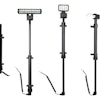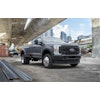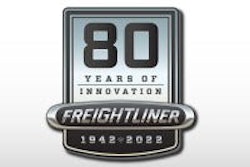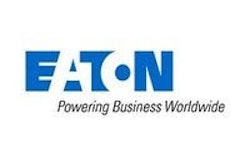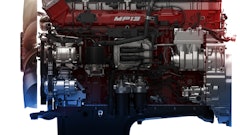
Heavy- and medium-duty truck transmissions are subject to a lot of stress over their lifetimes, but a preventive maintenance program can help avoid failures, minimize vehicle downtime and reduce the cost of repairs. Often transmission failure can be traced to poor maintenance.
“The most common failures involve interfaces, both mechanical and electrical,” says Alex Stucky, product strategy manager, linehaul, Eaton. Electrical interfaces include electrical connections (power supplies, inputs/outputs, sensors) and data links (controls). Mechanical interfaces include pilot bearings, the air supply, driveline connections and induced vibrations.
“The steps drivers and fleet managers can take to reduce the occurrence and severity of these issues is to proactively stay on top of preventive maintenance schedules and periodic inspections,” says Stucky. “For example, the sooner an oil leak is discovered, the cost of the repair can be dramatically reduced.”
Catch Problems Early
Drivers are critical to catching problems before costly catastrophic failures occur. They should check for oil leakage on the ground before starting the truck each morning, and visually check for leaks around bearing covers, PTO covers and other machined surfaces, including the output shaft seal. The main output shaft seal is where leaks commonly occur, and it must be repaired as it can lead to complete transmission failure.
Drivers also need to be vigilant to daily maintenance demands, like bleeding air tanks to remove water or oil since the air system is critical for functions such as the range shift on manual transmissions.
“Maintain the air system well — drain tanks, change coalescer filters, etc. — since the [transmission] relies on clean air from the vehicle to operate correctly,” advises Kelly Gedert, director of product marketing for Freightliner Trucks and Detroit.
Make sure drivers report any shifting-related problems, such as hard shifting or jumping out of gear. “Driver shift complaints can be an indication of an issue or emerging problem and should be addressed,” says Stucky.
With manual transmissions, typical problems may include unusual noises, leaks, vibrations, jumping out of gear and hard shifting. You will want to catch these issues early since they may be indications of impending bearing or gear failure.
The type of transmission can impact maintenance requirements. “The interface failure points are common to all transmission types, with the manual transmission being the exception since those do not have electrical interfaces,” says Stucky.
By comparison, automated mechanical transmissions (AMT) tend to be more immune to failures caused by driver abuse. “AMTs are more immune to maintenance issues considering the electronic system with a computer controlling components such as the clutch and gear shifting,” Stucky points out. “The controls can be optimized to extend clutch life and reduce opportunities for abuse.”
AMT maintenance is not necessarily different than a manual transmission. It still calls for oil changes, etc., as well as daily inspection and maintenance by drivers. “The wear items have changed and the list is shorter,” says Gedert. “But a driver who is not concerned with the longevity of the product can still have a negative impact on the life expectancy.”
Modern diagnostics tools can help pinpoint potential issues. “Automated transmissions are electronically controlled and have advanced diagnostics that typically require a PC-based service tool,” says Stucky. “These tools allow the technicians to quickly diagnose the product with a diagnostic trouble code (DTC) that is sent from the AMT electronic controller.”
Remote diagnostics are possible, as well. Automated products with web-based portals offer a number of advantages. “These advantages include comprehensive fault code action plans (FCAPS) that leverage an expert knowledge base and allow the shop to schedule service and order parts in advance,” says Stucky. (Visit Eaton’s IntelliConnect portal at www.eatonintelliconnect.com for more details.)
Keep Fluids on the Level
Using an approved fluid and maintaining the correct fluid level are the most important steps to promote transmission longevity. If these steps aren’t followed, no other preventive maintenance will be effective.
“It is critical to have proper oil levels to ensure proper gear and bearing life for automated and manual products,” notes Stucky. “Automated and manual transmission fluid levels are used for lubrication only, while the torque converter transmission cannot function without proper fluid levels.”
Refer to the service manual for the proper procedure to check the fluid level on a particular transmission. Often, it will be checked with the fluid at operating temperature and viewed through a fill hole or sight glass, usually located on the driver’s side of the transmission. Be aware that checking fluid levels while parked on grades can give misleading results.
Also bear in mind there is more than one potential cause for low oil levels. “Low oil level can occur from leaks as well as improper service and routine maintenance,” says Stucky.
When trying to identify the source of an oil leak, always check for a plugged transmission breather. Oil expands in volume as it warms up, so if the breather is plugged, it can result in seal failure.
Before adding oil, make sure you are using the correct fluid. “The type of oil can affect the viscosity and in turn the life and efficiency of the transmission,” says Stucky.
Most transmission manufacturers prefer synthetic lubricants since they provide better performance in resisting heat, cold, oxidation and shearing, all of which could shorten transmission life.
Only use the manufacturer recommended fluid. Non-approved lubricants can not only void the warranty, they can result in shorter bearing life and seal leakage. “Changing oil to an unapproved type can risk a failure in a very short time,” Gedert comments.
Also take care to avoid mixing brands, weights and types of fluid. Do not add a transmission lubricant without first checking which type is currently in use. Mineral-based gear oils, mineral-based engine oils and synthetic gear lubes are all approved for use in transmissions, yet none of them are particularly compatible. Mixing transmission oils causes accelerated lube breakdown, resulting in lubrication failures.
Check the oil level during lube inspections, since low oil levels indicate some sort of leak path, says Gedert.
Variations in oil level will also cause issues. Overfilling usually results in oil breakdown due to aeration caused by the churning action of the gears. Premature breakdown of the oil will result in varnish and sludge deposits that plug up oil ports and build up on splines and bearings. Under-filling results in oil starvation.
When checking the oil level, it is also a good time to check the torque of the bolts on the PTO flanges and covers.
Oil cleanliness is very important, as well. “Dirty oil can break down gears and bearings and is directly related to transmission life,” says Stucky. “The advice to fleets is to follow the manufacturers’ oil change and inspection intervals. Oil change intervals are the primary method to ensure proper oil condition.”
Stick to the schedule. “Change the oil per published guidelines,” says Gedert. “Failure to do so can reduce the life of the transmission by promoting premature wear on the metal surfaces and also affect other parts like the countershaft brake discs, which can be packed with sludge if the oil is not changed properly.
“Understand that oil change intervals and oil types are engineered and important,” Gedert emphasizes. “Don’t push intervals out, and be ready to adjust them shorter if the vehicle application requires it.”
For instance, Detroit requires Detroit Syn 75W-90 or another oil meeting the MB235.11 spec to be used in its DT12 AMT. “Use of the wrong oils will adversely affect the service life of seals and mechanical components,” says Gedert.
When draining transmission oil, check for metal particles in the oil, which can indicate excessive wear and may warn of an imminent failure. It is not unusual for a newly broken-in transmission to have minute metal particles held to a magnetic drain plug.
Take precautions in terrain where vehicles may be operated at extreme angles. Such conditions may require an oil pump or cooler to ensure the transmission receives proper lubrication. Check with your local dealer if the application will regularly exceed an operating angle of 12°.
Keep on Eye on Temperatures
“Excessive heat buildup in transmissions is most commonly caused by low oil or a breakdown in viscosity,” says Stucky. “The occurrence of this situation is higher in torque converter automatics considering the dependence on oil pressure for normal operation, which is also affected by temperature.”
Because of the friction of moving parts, transmissions will produce a certain amount of heat. The more horsepower and the higher the load factor, the more heat that is generated. It is dissipated through the transmission case. When conditions prevent proper heat dissipation, overheating occurs.
The transmission operating temperature should never exceed 250° F for an extended period of time. If it does, the loaded temperature of the gear teeth could reach a level that will destroy their heat treat, and oil life could be shortened.
There are many situations that can lead to overheating, including:
- Improper lubrication
- Oil level too low or too high, wrong type of oil, or an operating angle of more than 12°
- Operating consistently at slow speed
- Restricted air flow around transmission due to the transmission being “boxed in” by frame rails, deck lids, fuel tanks and mounting brackets, or by a large bumper assembly
- Exhaust system too close to the transmission
- High-power PTO operation for extensive periods while stationary
- High ambient temperatures
- High horsepower, overdrive operation
- Use of engine retarder
- Coasting downhill with the clutch depressed
- High engine RPM for extensive periods
In some cases, an external oil cooler kit can be used to correct overheating problems. Eaton recommends transmission oil coolers on engines of 350 hp or more.


